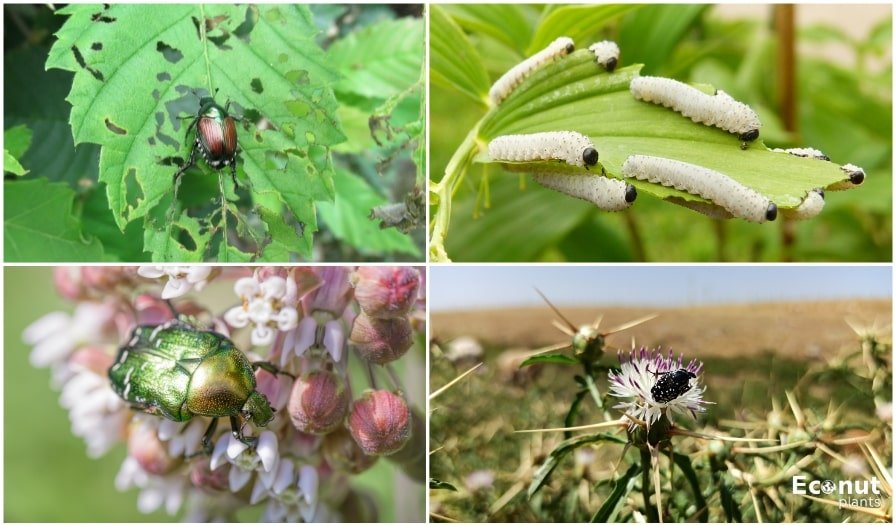Have you noticed any holes in the leaves of your roses? Rose leaves that have been munched on are not uncommon, but who is usually to blame? Explains seven possible causes of holes in rose leaves in this article, along with some remedies.
1. Slugs/Snails
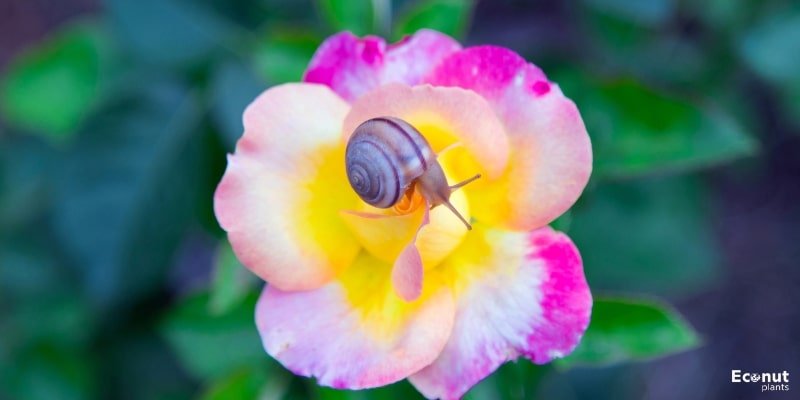
Though they are typically the enemy of vegetable gardeners, slugs and snails can also attack roses. They often only harm the lower leaves and canes, leaving behind jagged holes and mucus trails.
When these molluscs are active at night, this is the best time to find them. Though they aren’t always fussy, they generally like herbaceous plants over huge woody perennials like roses.
Identification
Slugs and snails are slithering molluscs that eject slime trails surrounding their damaged areas, causing them to seem ragged and withered. Slugs’ bodies are similar to those of snails, except that they do not have spiralled shells on the outside.
The Fix
- Arrange your roses with vertical copper screens in between.
- Remove any dead leaves and sticks that your roses may be using as cover and moisture from their base.
- Put beer traps to use.
- Use a torch to locate them at night, and then remove them by hand.
2. Fuller Rose Beetle

Rose weevils, or fuller rose beetles, enjoy munching on the notches in leaves. Their holes are ragged and irregular, not like the clean, smooth-edged notches made by leafcutter bees, so you can tell them apart from each other’s damage. These beetles have brown, greyish-grey, pointy snouts that are reminiscent of weevils. Each one is ⅓ inch long.
They are born on earth as grubs that eat the roots of plants. Larger rose beetles can be ignored in small quantities because they often don’t cause significant harm. Wasps, parasites, and ladybirds feed on them.
Identification
Night-time is when these insects are most active. Look for jagged, serrated leaf margins that have been chewed. During the day, they dig holes in the ground, and then at night, they climb roses to find food.
The Fix
- Encircle your rose’s base with tape, sticky side out. They won’t be able to ascend over the barrier because they can’t fly.
- Plant companion plants that attract predators, such as sweet alyssum, yarrow, and alliums.
- Early spring is the best time to find them (May or June) and remove them by hand.
- Construct a ground trap or buy one.
3. Leafcutter Bees
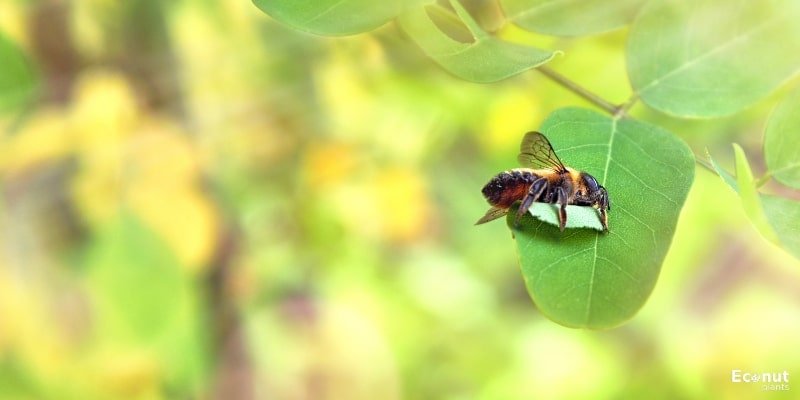
Leafcutter bees may have visited your rose garden if you notice neat, round scratches at the margins of your leaves. Both household gardens and the agricultural industry enjoy these helpful pollinators.
The sizes of leafcutters and honeybees are comparable. They don’t harm your rose in any way over time, nor do they truly consume the leaves. Rather, they use their scissor-like jaws to chop off little bits. After that, they roll leaves into tubes, stuff them with pollen, and line their nests with them.
Identification
Bees called leafcutters make smooth, circular incisions on the edges of leaves. The bees themselves have hairy black bodies with light striping, measuring about ¼ inch. Females’ undersides are coated in scopa, which are pollen-collecting hairs, in place of pollen sacs.
The Fix
No need for a fix! Because they are important pollinators, gardeners should support leafcutter bees. Both the rose and its leaves will continue to be healthy. Move on, enjoying the intriguing hole-punched appearance.
4. Rose Chafer Beetle
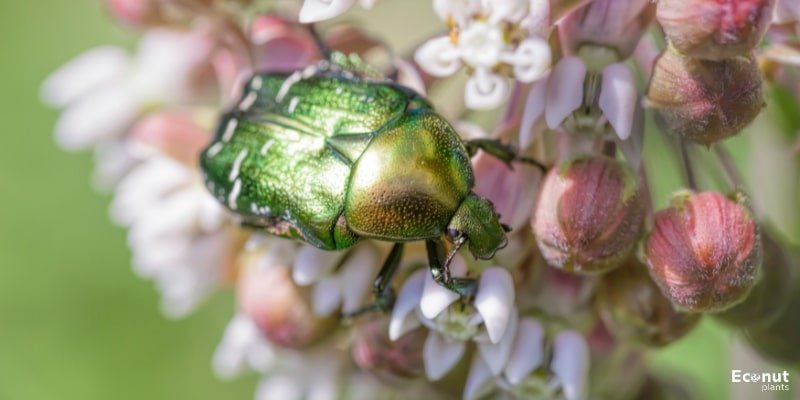
The little yellow hairs that sprout on the head and thorax of rose chafer beetles, Macrodactylism sub spinous, give them a tan appearance and fuzzy appearance. They are found in eastern North America, where they seem to prefer sandy areas.
Rose chafers often have a length of ½ inch. They start as large, white, C-shaped grubs that hibernate in the ground and emerge in the early spring.
They consume a wide variety of other beautiful plants and vegetables, such as peppers, grapes, and strawberries, in addition to roses. When consumed by dogs, cats, or birds, they become lethal due to the poison they contain.
Identification
Rosebuds, leaves, and flowers are consumed by rose chafers. Large, asymmetrical gaps between the veins can be seen in the leaves.
They will consume a lot, frequently skeleton-zing the leaves completely. When the beetles are in their 3–4-week adult stage, they are noticeable and large enough to be identified.
The Fix
- The best method is to remove the afflicted roses by hand if the number of roses is limited.
- After removing them, submerge them in soapy water.
- If they happen every year, maybe cover your roses with a cheesecloth before they bloom in May or June.
- Invest in specific sticky traps.
- For large-scale infestations, apply a pesticide only after all other measures have been exhausted.
5. Hail
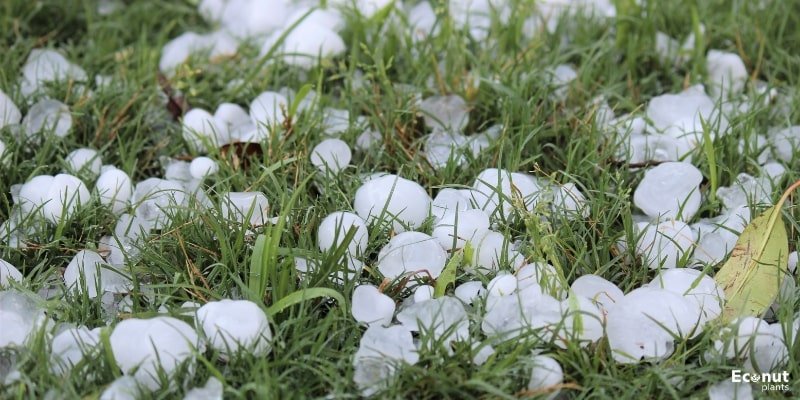
Storm damage can also seriously harm roses, even though insect pests are the main suspect. Hail can split delicate stems, pierce foliage, and injure canes.
To prevent damaged foliage and lost blossoms from strong hail, keep a watch on the weather. Put up a covering to shield your roses from impending storms.
Identification
Hail typically occurs in the spring, though it can accompany thunderstorms at any time of year. Though most hailstones are pea-sized, the largest ones have the potential to grow to the size of a golf ball and can be rather harmful.
The Fix
- In a standard garden bed, protection against hail can be obtained using a large tarp tied with stones and held up by sturdy poles.
- Large boards leaning against a wall or fence might protect roses growing along them.
- Use an overturned bucket to protect small seedlings.
- Build up the soil at the base of your main rose canes to strengthen them.
6. Sawfly Larvae
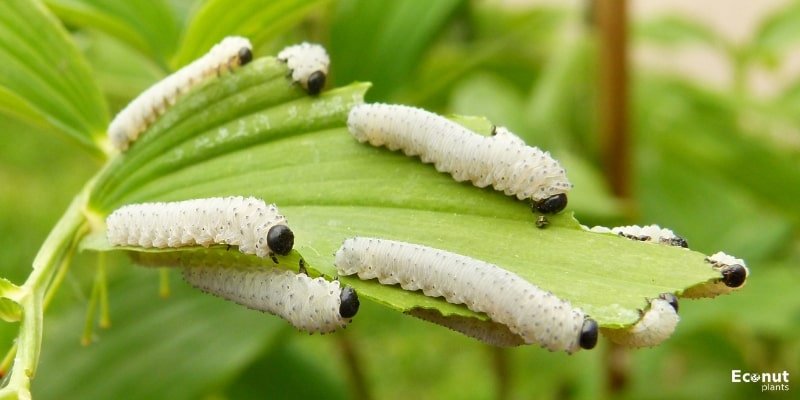
The larvae of sawflies, often known as rose slugs, resemble tiny green caterpillars. As an adult, they are non-stinging, dark-coloured wasps. When the temperature gets warmer in the early spring, that’s when they usually come out.
Correctly identifying sawfly larvae is essential since they bear similarities to numerous other species of caterpillars. Roses are also consumed by moth and butterfly caterpillars, but instead of destroying them, relocate them to a different area of the garden.
Sawfly larvae that have just hatched enjoy munching on rose leaves, which results in tan, almost transparent patches known as “windowpanes.” They develop uneven holes as they get older.
Identification
Keep an eye out for bigger holes and tan “windowpane” spots on foliage. Turn the leaves over and look for green caterpillars with tan heads that are hairless. Frequently, they form groups around them.
The Fix
- Plant companion plants to ward against infestations. If you provide a wide variety of plants to attract birds, lacewings, and ladybirds, they will consume sawfly larvae.
- Pick them by hand from the leaves and place them in soapy water to remove them. Insecticides will kill their natural predators and are unnecessary.
- Roses seldom suffer life-threatening damage; thus, the best course of action is usually to tolerate the damage at first.
7. Japanese beetle
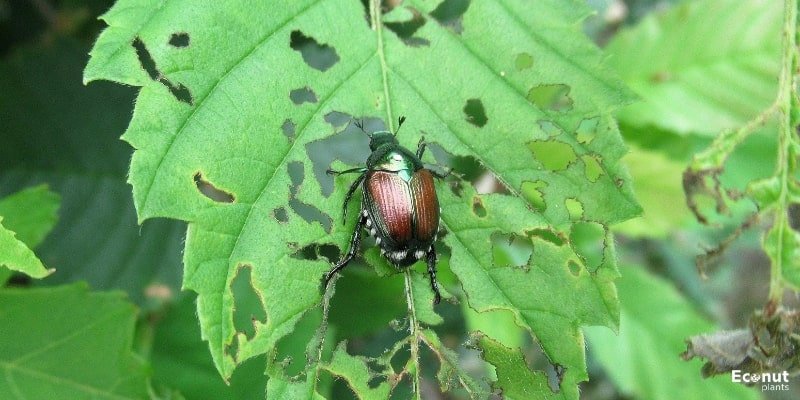
It will be obvious if you have Japanese beetles! They forage during the day, unlike other beetles. Their copper-headed, metallic green bodies are robust, and they measure about 1.5 inches in length. What set them apart are the white patches of hair close to their legs.
The Eastern United States is seeing an increase in the presence of these Japanese-born invasive rose pests. In the spring, their white grubs emerge from the ground to eat the roots of turf grass. They hibernate over the winter.”
Their pupation and transformation into adulthood will occur in the early summer. Roses suffer grave harm from Japanese beetles, which consume leaves, buds, and blossoms.
Identification
Find any leaves that have skeletonized. Blossoms may be stunted, discoloured, and never open. For the beetles themselves, look for open blossoms.
The Fix
- Kill the bacteria at the grub stage by applying a bacterial control known as milky spore to the soil.
- When the beetles are still slow in the morning, manually remove the adult ones from the roses.
- Combine roses with plants that repel them, such as catnip, geraniums, and alliums.
- Pesticides and traps have not worked on Japanese beetles, so don’t spend your time using them.
Conclusion
The majority of bugs that pierce leaves don’t always indicate that something is wrong. Finding the root of the issue can help you decide on the best course of action. Encourage natural predators and stay away from chemicals if a bug is a problem. They weaken beneficial predators, breed resistant pests, and degrade the condition of your garden.
Strong, healthy roses are less likely to suffer significant damage from pests or bad weather. Plant a companion plant, give your roses proper pruning and watering, and have fun with them!

